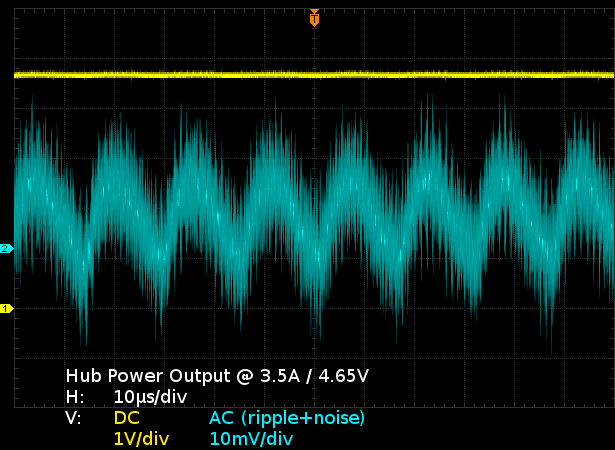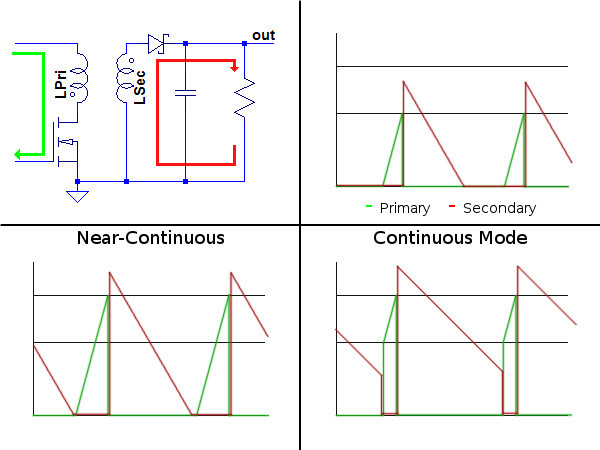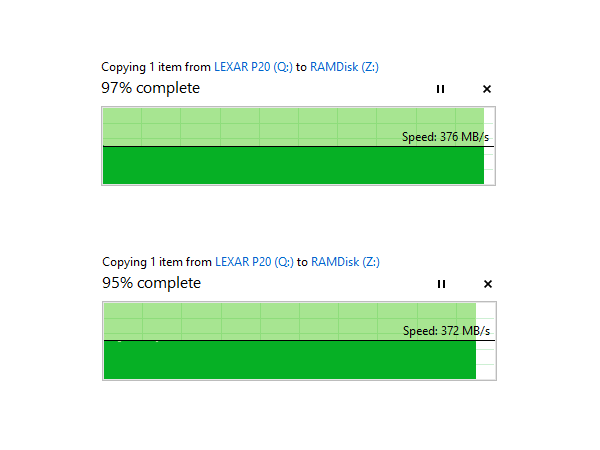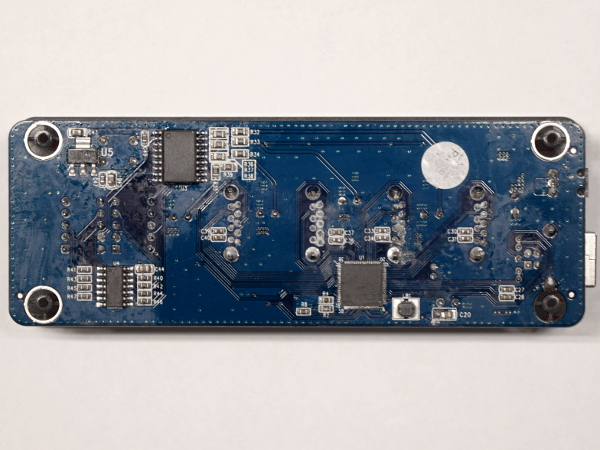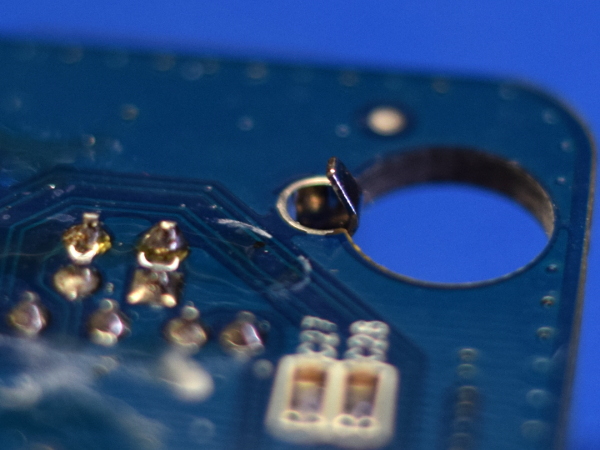Silverstone SST-EP03 Tear-Down
Power With Hub
How much does passing through the hub affect the AC adapter’s power quality and voltage? I expected all of those 100µF capacitors to smooth things out considerably, but instead I measured considerably more noise. The result is still within about 50mVPP, including ripples. Also, thanks to the added series resistance of the fuse and current-sensing resistor, voltage at the ports loses an additional 100mV. Do you know what I think might improve that? Installing a quality capacitor on the vacant EC6 footprint.
The highest current I could pull through one port without tripping the AC adapter’s over-current protection was 4.1A, and at that current, the hub’s PTCs needed as many as 10 seconds to cut off and 30 seconds to recover.
MORE: Best Power Supplies
MORE:10 Inexpensive Automotive USB Adapters Tested
Preemptive Repair
Instead of waiting for future trouble to find me, requiring a repair when I might not have time for one, I chose to fix a potential issue for curiosity’s sake. Rummaging through my spare parts inventory, I picked out a 330µF 25V Nichicon VK; it was the only capacitor I had in stock that fit the footprint and top cover's 12mm height clearance.
MORE: Best PC Builds
MORE: Best Cases
Get Tom's Hardware's best news and in-depth reviews, straight to your inbox.
Any Improvement?
From roughly 50mVPP down to 10mVPP, I'd call that a significant improvement. For the Chengx capacitors to provide effectively no high-frequency noise and ripple filtering compared to what comes directly from the AC adapter, and a single good capacitor to improve supply bypass performance so much, the Chengx capacitors’ ESR must be significant. Having a fuse and 0.1Ω resistor in series with four of them does not help either.
Looking at output voltage, another oddity shows up: it drops to 3.7V at 3.5A, far below the USB specification’s 4.4V minimum. And I can only pull 1.8A out of my modified hub before hitting 4.4V at the port. The reduced load impedance must have caused the AC adapter’s fly-back transformer to enter continuous mode and become current-limited from the primary side.
MORE: Best Deals
MORE: Hot Bargains @PurchDeals
Fly-Back 101
While the FET is conducting, energy gets stored in the transformer’s magnetic field via the primary winding. When the FET turns off, the collapsing magnetic field induces a current in the secondary that gets filtered to become the output voltage. When current through both windings is allowed to reach zero, this is called discontinuous mode.
Now for the counter-intuitive bit: in a magnetic circuit, the higher the load, the longer it takes the transformer to dump its energy. When a transformer enters continuous mode, its magnetic field never gets a chance to reset, its primary current rises, the FET’s on-time gets truncated by the primary current limit represented by the top horizontal line, and output voltage collapses.
Loss of regulation aside, this should be harmless to properly designed fly-back converters and most loads.
MORE: Best Power Supplies
MORE:10 Inexpensive Automotive USB Adapters Tested
Hub Performance
To evaluate performance, I performed a simple file copy of a Windows 10 ISO from the fastest USB drive I currently own (64GB Lexar P20) to a RAM drive. One test utilized my PC's integrated H77-based USB ports, and another ran with the EP03 in-between.
Can you tell which graph is which? Both are practically flat lines at just over 370MB/s, merely 1% apart. If you must know, the native port is on top. In short, SilverStone's performance is effectively indistinguishable from native USB 3.0.
MORE: Best PC Builds
MORE: Best Cases
I Only Want You Gone
Before putting the hub back together, I decided to take another shot at cleaning the flux using a blend of propanol, methanol, and methyl-acetone. This proved mildly more effective in areas I could scrub using towels, but not so much between pin rows that I could only reach with a brush. After a few iterations of soaking flux puddles with flux remover and scrubbing, I managed to thin them out enough to wipe their bulk off, but spread a thin layer of diluted residue across most of the board in the process.
Eventually I gave up on making the board nice and clean. That tacky flux residue simply doesn’t want to go away. At least not with this solvent mix.
MORE: APC BGE90M-CA Tear-Down
MORE: CyberPower EC350G Tear-Down
The Takeaway
I'm a little disappointed that the only aluminum in SilverStone's construction is a thin cover liner, and I'm irked by the Type B connector’s solder-less shield tab. Aside from that, the built-in meter is usable and the hub performed as well as could be expected in my basic test. Perhaps more important, the AC adapter met all of its specifications before I modified the hub. While I have little doubt that the EP03 will serve my modest requirements well for years to come, I did expect higher build quality from a device that should sell for around $35 based on European prices.
As I put this piece together, I poked around SilverStone’s other samples, identified a number of issues, discussed them with a company representative, who encouraged me to be as thorough as I wanted, and passed my feedback along to product managers. Give SilverStone some kudos for openly accepting constructive criticism.
Will its other samples fare better? We’ll see.
MORE: Best Deals
MORE: Hot Bargains @PurchDeals
-
Daniel Sauvageau Many people say that reviewers get cherry-picked samples. As my contact at Silverstone told me when I sent him a copy of my tear-down as a heads-up for what was coming, reviewers get whatever inventory is in the warehouse like everybody else and I doubt anybody will dispute that here.Reply -
itsnotmeitsyou This was awesome. Thanks for this kind of content TH. Makes this feel like a real technically oriented website instead of just tech gossip. Kinda felt like that was where things were headed for a while.Reply -
jtd871 Good on SilverStone for asking for your unvarnished criticism. But it's disappointing that SS's own QA/QC doesn't pick up these issues.Reply -
Daniel Sauvageau Reply
Most of these were more 'quibbles' than serious issues though: as long as the flux is non-corrosive at room temperature, there is nothing technically wrong with leaving the finished PCB drowned in it. Solder blobs may not be pretty but as long as they don't touch anything they shouldn't, there is nothing wrong with those either. Ripples and noise on VBus may not be pretty but section 11.4.4.2 of the USB 3.1 spec (VBus) does not have a noise or ripple specification. Anything from 4.45V to 5.25V appears to be fair game.18896400 said:Good on SilverStone for asking for your unvarnished criticism. But it's disappointing that SS's own QA/QC doesn't pick up these issues.
The only real issue I have with it is the mechanical/shield hole on the upstream port since leaving one tab loose means more stress on the data pins when the cable gets (dis)connected or tugged. SilverStone told me one tab is enough, but I don't have to like it.
